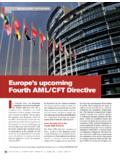Transcription of Financial Action Task Force Groupe d'action financière
1 Financial Action Task Force Groupe d' Action financi re RBA GUIDANCE FOR accountants . 17 June 2008. FATF/OECD 2008. All rights reserved. No reproduction, copy, transmission or translation of this publication may be made without written permission. Applications for permission to reproduce all or part of this publication should be made to: FATF Secretariat, OECD, 2 rue Andr Pascal 75775 Paris Cedex 16, France TABLE OF CONTENTS. SECTION ONE: USING THE GUIDANCE - PURPOSE OF THE RISK-BASED Chapter One: Background and Context ..1 Chapter Two: The Risk-Based Approach Purpose, Benefits and Challenges ..4 Chapter Three: FATF and the Risk-Based Approach ..7 SECTION TWO: GUIDANCE FOR PUBLIC AUTHORITIES.
2 12 Chapter One: High-level Principles for Creating a Risk-Based Approach ..12 Chapter Two: Implementation of the Risk-Based Approach ..15 SECTION THREE: GUIDANCE FOR accountants ON IMPLEMENTING A. RISK-BASED APPROACH ..21 Chapter One: Risk Chapter Two: Application of a Risk-based Approach ..25 Chapter Three: Internal Controls ..28 ANNEXES ..30. ANNEX 1 SOURCES OF FURTHER INFORMATION ..30 A. Financial Action Task Force documents ..30 B. Other sources of information to help assist countries' and accountants ' risk assessment of countries and cross-border activities ..30 ANNEX 2 GLOSSARY OF ANNEX 3 MEMBERS OF THE ELECTRONIC ADVISORY GROUP ..34. GUIDANCE ON THE RISK-BASED APPROACH.
3 TO COMBATING MONEY LAUNDERING AND. TERRORIST FINANCING. HIGH LEVEL PRINCIPLES AND PROCEDURES FOR. accountants . SECTION ONE: USING THE GUIDANCE. PURPOSE OF THE RISK-BASED APPROACH. Chapter One: Background and Context 1. In June 2007 the FATF adopted Guidance on the Risk-Based Approach to Combating Money Laundering and Terrorist Financing: High Level Principles and Procedures, which includes guidance for public authorities and guidance for Financial institutions. This was the culmination of extensive consultation between private and public sector members of an Electronic Advisory Group (EAG) established by the FATF. 2. In addition to Financial institutions, the FATF Recommendations also cover a number of designated non- Financial businesses and professions (DNFBPs).
4 At its June 2007 meeting, the FATF's Working Group on Evaluations and Implementation (WGEI) endorsed a proposal to convene a meeting of representatives from the DNFBPs to assess the possibility of developing guidance on the risk-based approach for their sectors, using the same structure and style as the completed guidance for Financial institutions. 3. This meeting was held in September 2007 and was attended by representatives of organisations which represent lawyers, notaries, trust and company service providers, accountants , casinos, real estate agents, and dealers in precious metals and dealers in precious stones. This private sector group expressed an interest in contributing to FATF guidance on implementing a risk-based approach for their sectors.
5 The guidance for the DNFBPs would follow the principles of the risk-based approach already established by FATF, and would highlight risk factors specific to the DNFBPs, as well as suggest mitigation strategies that fit with the particular activities and businesses of the DNFBPs. The FATF established another EAG to facilitate the work. 4. The private sector group met again in December 2007 and was joined by a number of specialist public sector members. Separate working groups comprising public and private sectors members were established, and private sector chairs were appointed. 5. The EAG continued work until this guidance for accountants was presented to the WGEI.
6 After further international consultation with both public and private sectors, the FATF adopted this guidance at its June 2008 Plenary. Guidance for each of the other DNFBP sectors is being published separately. Purpose of the guidance 6. The purpose of this guidance is to: Support the development of a common understanding of what the risk-based approach involves. Outline the high-level principles involved in applying the risk-based approach. Indicate good practice in the design and implementation of an effective risk-based approach. 7. However it should be noted that applying a risk-based approach is not mandatory. A properly applied risk-based approach does not necessarily mean a reduced burden, although it should result in a more cost effective use of resources.
7 For some countries, applying a rules-based system might be more appropriate. Countries will need to make their own determinations on whether to apply a risk-based approach, based on their specific ML/FT risks, size and nature of the DNFBP activities, and other relevant information. The issue of timing is also relevant for countries that may have applied anti- money laundering/combating the financing of terrorism (AML/CFT) measures to DNFBPs, but where it is uncertain whether the DNFBPs have sufficient experience to implement and apply an effective risk-based approach. Target audience, status and content of the guidance 8. This guidance has been prepared for, and in relation to, accountants in public practice 1.
8 The roles and therefore risks of the different DNFBP sectors are usually separate. However, in some business areas, there are inter-relationships between different DNFBP sectors, and between the DNFBPs and Financial institutions. For example, accountants may be instructed by businesses or professionals within other DNFBP sectors or by Financial institutions. accountants may also undertake trust and company services covered by the FATF Recommendations. For such activities, accountants should make reference to the guidance on the risk-based approach for Trust and Company Service Providers (TCSPs). 9. DNFBPs provide a range of services and activities that vastly differ, in their methods of delivery and in the depth and duration of the relationships formed with clients, and the size of their operation.
9 This Guidance is written at a high level to cater for the differing practices of accountants in different countries, and the different levels and forms of supervision or monitoring that may apply. Each country and its national authorities should aim to establish a partnership with its accountants and other DNFBP sectors that will be mutually beneficial to combating money laundering and terrorist financing. 10. The primary target audience of this guidance is the accountants themselves, when they conduct activities which fall within the ambit of the FATF Recommendations, as described below. 11. Recommendation 12 mandates that the requirements for customer due diligence, record- keeping, and paying attention to all complex, unusual large transactions set out in Recommendation 5, 6, and 8 to 11 apply to DNFBPs in certain circumstances.
10 Specifically, Recommendation 12 applies to accountants when they prepare for or carry out transactions for their client concerning the following activities: Buying and selling of real estate;. Management of client money, securities or other assets;. Management of bank, savings or securities accounts. Organisation of contributions for the creation, operation or management of companies. 1. This refers to sole practitioners, partners or employed professionals within professional firms. It is not meant to refer to internal professionals that are employees of other types of businesses, nor to professionals working for government agencies, who may already be subject to measures that would combat money laundering.















